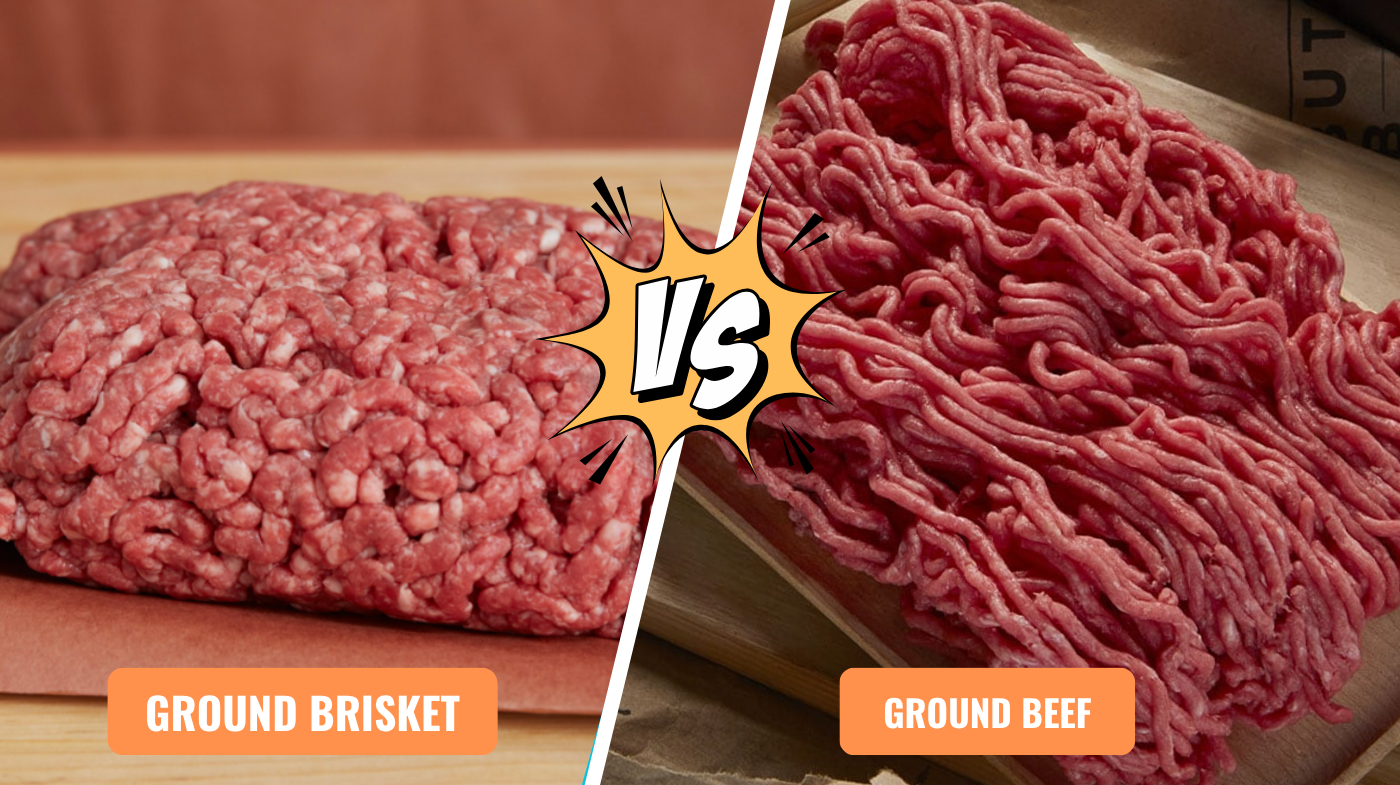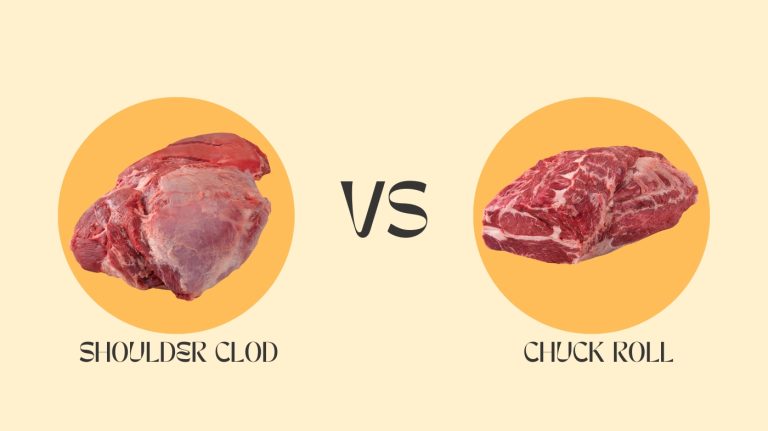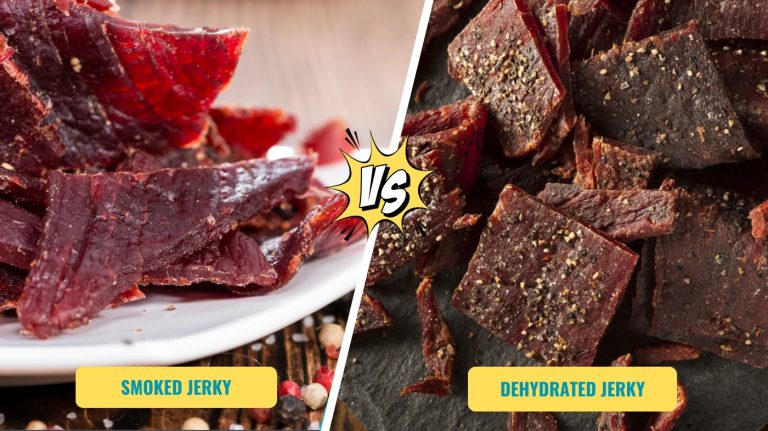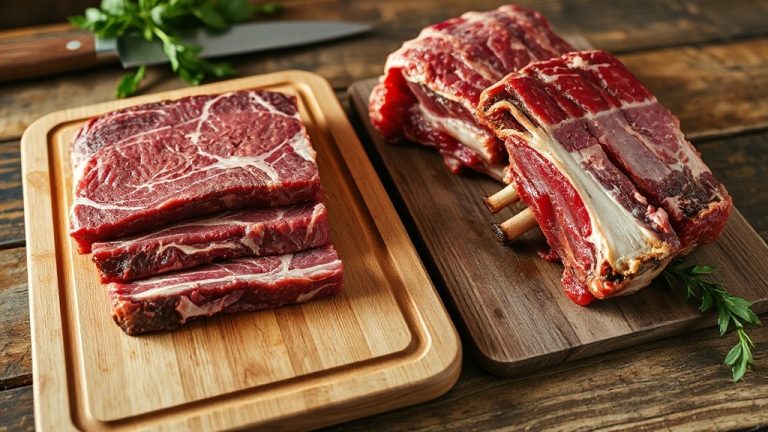Ground Brisket vs Ground Beef: Which Suits Your Meal Best?
When choosing between ground brisket and ground beef, consider that brisket contains more fat, offering richer flavor and juicier texture, ideal for BBQs and slow-cooked dishes.
Ground beef is leaner and more versatile, better suited for quicker meals and lower-fat diets. Nutritionally, brisket provides more saturated fat and certain B vitamins, while ground beef delivers more micronutrients like B12 with fewer calories.
Understanding these differences helps you pick the best meat for your cooking style and health goals—explore further to optimize your choice.
Key Takeaways
- Ground brisket has higher fat content (around 20%) than typical ground beef, offering richer flavor and juiciness but more calories.
- Ground brisket provides more zinc, selenium, and B vitamins B2, B3, and B6, while ground beef offers higher B12 and B5 levels.
- Brisket’s fat and connective tissue create tender, flavorful meat ideal for slow cooking and BBQ, unlike the more versatile ground beef.
- Ground beef’s leaner profile suits quick cooking methods like grilling and pan-frying, making it more adaptable for diverse recipes.
- Both meats pose health risks if overconsumed or cooked at high temperatures; slow cooking brisket reduces harmful compounds and improves tenderness.
Comparison Table Between Ground Brisket and Ground Beef
| Aspect | Ground Brisket | Ground Beef |
|---|---|---|
| Fat Content | Higher fat content (around 20% or more) | Variable fat content (70/30 to 93/7 lean-to-fat ratio) |
| Flavor Profile | Intense, robust beefy flavor with complex taste | Neutral taste that adapts well to seasonings |
| Texture | Exceptionally juicy and tender due to well-distributed fat | Denser texture, varies based on fat content |
| Calories | Higher calories due to increased fat content | Lower calories in lean varieties |
| Nutritional Benefits | Higher in zinc, selenium, and B vitamins (B2, B3, B6) | Higher in vitamin B12 and B5, better micronutrient density |
| Saturated Fat | More saturated fat – requires moderation | Lower saturated fat profile in lean cuts |
| Protein Efficiency | Less efficient protein-to-calorie ratio | More efficient protein-to-calorie ratio |
| Best Cooking Methods | Slow cooking, pan-searing, grilling at moderate heat | Quick, high-heat methods like grilling and pan-frying |
| Ideal Temperature | 225°F-325°F for optimal results | Medium-high heat for rapid browning |
| Common Uses | Brisket burgers, chili, fricadelles, BBQ applications | Tacos, meatloaf, shepherd’s pie, versatile base |
| Handling Requirements | Careful processing to avoid stringiness | More forgiving during preparation |
| Health Considerations | Higher cardiovascular risk if overconsumed | Better for low-fat diets and weight management |
| Moisture Retention | Superior moisture retention during cooking | May dry out if overcooked, especially lean varieties |
| Diet Compatibility | Ideal for keto/low-carb diets requiring higher fat | Suitable for balanced, health-conscious diets |
| Flavor Enhancement | Rich enough to stand alone with minimal seasoning | Requires more seasoning to develop complex flavors |
| Storage Considerations | Longer thawing times due to higher fat content | Standard thawing times for ground meat |
Fat Content Differences
How does fat content influence the qualities of ground brisket versus ground beef? Ground brisket typically contains higher fat levels, especially if the deckle fat isn’t trimmed, often yielding an 80/20 lean-to-fat ratio when trimmed.
This higher fat content also contributes to a juicier texture and richer flavor, much like the fat marbling valued in smoked game birds for enhanced taste.
Ground beef fat content varies widely, from 70/30 to 93/7, depending on the cuts used like chuck or round and trimming methods.
This variability directly impacts cooking properties: brisket’s higher fat enhances juiciness and flavor, ideal for burgers, while leaner ground beef results in a denser texture preferred in health-conscious applications.
In practice, discarding about a pound of fat from an 11.4-pound brisket can reduce the fat ratio to approximately 21% fat, affecting the final product’s richness.
Fat within the meat, or marbling, and regional preferences also affect the final fat content. Adjusting fat by trimming brisket or blending beef cuts lets you tailor the flavor and texture to your precise culinary needs.
Nutritional Profiles Compared
Fat content not only shapes the texture and flavor of ground brisket and ground beef but also considerably impacts their nutritional profiles.
Ground brisket contains more calories and saturated fat due to its higher fat percentage, whereas lean ground beef offers a more efficient protein-to-calorie ratio.
Additionally, ground brisket has a higher amount of monounsaturated fat, which can influence heart health differently compared to the fat profile in lean ground beef. The use of flavorful fats in cooking can be enhanced by sauces like Maull’s BBQ Sauce, which complement the richness of brisket.
Both provide substantial iron, but brisket, derived from steak cuts, tends to be richer in zinc, selenium, and B vitamins like B2, B3, and B6. Ground beef, however, generally delivers more vitamin B12 and B5. Steak also contains significantly more magnesium and calcium, enhancing its mineral content.
While ground brisket’s fat enhances palatability, it results in a less favorable nutrient balance compared to lean ground beef, which offers a superior overall micronutrient density. Therefore, your choice depends on whether you prioritize flavor and fat content or lean protein and micronutrient efficiency.
Health Implications of Each Option
Although both ground brisket and ground beef offer nutritional benefits, their health implications differ markedly due to variations in fat content, nutrient density, and potential risks.
Ground brisket, rich in oleic acid and monounsaturated fats, may improve HDL cholesterol and reduce cardiovascular risk factors. However, its higher saturated fat and calorie content demand moderation to avoid adverse effects.
Additionally, grass-fed beef, which can include some brisket cuts, contains up to six times more omega-3 fatty acids than grain-fed beef, contributing to heart health benefits. When smoking brisket, maintaining a consistent smoker temperature between 225°F and 275°F helps preserve its nutritional profile while enhancing flavor.
In contrast, lean ground beef provides essential nutrients like iron and protein with a lower saturated fat profile. Yet, excessive intake risks iron overload and elevated cholesterol.
Both meats pose carcinogenic risks when smoked or grilled due to HCAs and PAHs formation. Proper cooking temperatures mitigate bacterial contamination and parasite risks, particularly with ground beef.
Flavor and Texture Variations
When comparing ground brisket and ground chuck, you’ll notice distinct differences in both flavor and texture that stem largely from their fat content and muscle composition.
Ground brisket, with over 20% fat, delivers an intense, beefy flavor and exceptional juiciness due to its well-distributed fat and connective tissue. This higher fat content makes ground brisket especially ideal for juicy burgers, and its unique composition influences the energy density perceived in cooking results.
Ground chuck, containing 15–20% fat, provides a richer, beefier taste with a slightly denser texture. Its fat ratio and muscle structure affect how heat is absorbed and retained during cooking, impacting overall flavor and moisture.
- Flavor Intensity: Brisket offers a more complex, robust flavor; chuck balances richness and juiciness.
- Texture: Brisket’s higher fat ensures tenderness and moisture; chuck’s marbling maintains juiciness but can be denser if overworked.
- Handling Sensitivity: Brisket requires careful processing to avoid undesirable stringiness or toughness.
Ideal Cooking Methods for Each
Understanding the distinct flavor and texture profiles of ground brisket and ground beef guides you in selecting the best cooking methods to optimize their qualities.
For ground brisket, moderate heat and slower cooking preserve its higher fat content and juiciness. Pan-searing, grilling, or simmering in sauces suits it well, while smoking or oven-roasting patties at 225°F–325°F enhances flavor. Use a meat thermometer to avoid overcooking and fat loss.
Additionally, letting the cooked brisket rest for 15 minutes before serving helps retain its juices and improve tenderness, which is especially important for cuts with higher fat content like brisket letting brisket rest. The presence of intramuscular fat similar to that found in Wagyu contributes to its rich, buttery texture and flavor.
Ground beef, typically leaner, benefits from quick, high-heat methods like grilling or pan-frying to achieve rapid browning. It’s versatile for sautéing, stir-fries, or simmered dishes at lower heat to prevent toughness.
Managing cooking temperatures carefully helps retain moisture and flavor, much like the searing techniques used for premium beef sliders medium-high heat searing.
Manage grease by draining lean blends and ensure internal temperatures reach 160°F for safety with both meats.
Common Culinary Uses
You’ll find both ground brisket and ground beef excel in slow-cooked dishes, where extended heat breaks down connective tissue to enhance tenderness and flavor. However, moisture levels and cooking environment, such as humidity, can affect how flavors develop during the cooking process.
Their versatility allows you to incorporate them into recipes ranging from chili to stuffed peppers, adapting texture and taste to your preference.
Applying targeted flavor enhancement techniques, like seasoning blends or smoke infusion, can further elevate the distinct profiles each meat offers.
By grinding twice with different attachments, you ensure a more evenly mixed fat and lean content, improving the texture and flavor of your dishes.
Slow Cooking Benefits
Although slow cooking demands more time, it transforms tougher cuts like brisket and ground beef into tender, flavorful dishes ideal for stews, casual meals, and holiday feasts.
This method breaks down collagen into gelatin, enhancing texture and juiciness while preserving protein and nutrients through low-temperature cooking.
To maximize moisture and tenderness, it is beneficial to allow the meat to rest for several hours using resting techniques that retain heat and flavor.
You’ll also reduce harmful compounds formed by high heat, making meals healthier. Slow cooking helps avoid the formation of harmful compounds such as heterocyclic amines and polycyclic aromatic hydrocarbons that result from grilling or frying at high temperatures.
Consider these benefits:
- Improved Texture and Flavor: Slow cooking extracts deep flavors and tenderizes meat by breaking down connective tissue.
- Nutrient Retention: Gentle heat preserves vitamins and increases bioavailability of collagen and glycosaminoglycans.
- Digestive Ease and Health: The gelatin-rich food aids digestion and joint health, reducing inflammation and supporting bone strength.
Versatile Recipe Options
When exploring versatile recipe options, both ground brisket and ground beef offer distinct advantages that cater to various culinary applications.
Ground brisket, with its higher fat content and robust beefy flavor, excels in recipes like brisket burgers, chili, and fricadelles, where richness and texture are key.
It is especially favored for BBQs and grill weekends due to its deep, robust flavor that elevates the burger experience. Additionally, incorporating smoked garlic can enhance the flavor profile, adding a rich, bold aroma that complements the meat’s natural taste.
Conversely, ground beef’s neutral taste and leaner profile make it ideal for tacos, meatloaf, and shepherd’s pie, providing a flexible base that adapts well to diverse seasoning.
Both meats perform well in grilling, pan-frying, baking, and air frying, supporting an array of dishes from patties to stuffed vegetables.
Flavor Enhancement Techniques
Since ground brisket naturally offers a richer fat content and robust beef flavor, applying specific flavor enhancement techniques can markedly elevate your dishes.
You’ll want to optimize its moisture retention and flavor absorption to capitalize on its unique profile. Consider these approaches:
- Brining and Marinating: Use salt-based brines or acidic marinades to penetrate the meat deeply, improving juiciness and intensifying flavor.
- Spice Blending and Dry Rubs: Combine complementary spices like cumin, chili powder, garlic powder, and black pepper to create complex, layered taste profiles tailored to your dish.
- Searing and Aromatics: Sear ground brisket quickly over high heat to lock in juices and add sautéed aromatics such as garlic and onions for enhanced savory notes.
- Incorporating a homemade BBQ sauce like Myron Mixon’s can further complement and enhance the smoky, savory qualities of ground brisket.
Market Availability and Pricing Trends
How will shifting supply and demand dynamics shape the availability and pricing trends for ground brisket and ground beef in 2025? With U.S. beef production declining by 2.1% and tightening cattle inventories, you’ll see reduced beef availability, impacting both markets.
Additionally, record carcass weights in 2024 have temporarily boosted meat supply but are unlikely to offset production declines next year.
Declining U.S. beef production and tighter cattle inventories will reduce availability, impacting ground brisket and ground beef markets in 2025.
Ground brisket faces growth fluctuations due to supply chain challenges, yet digitalization and strong consumer preference for healthier options support resilience.
Ground beef production drops further with slower fed cattle slaughter, tightening supplies amid robust demand. Pricing will remain elevated; cattle and beef prices are expected to stay strong, pressured by narrow profit margins and regulatory frameworks.
Tariff changes may indirectly influence brisket pricing. To navigate this, you must adapt supply chain strategies and comply with evolving regulations, ensuring sustainable market presence amid these tightening and competitive conditions.
Making the Right Choice for Your Diet
Although both ground brisket and ground beef offer substantial protein, choosing the right option depends on your dietary goals and health considerations.
Ground brisket contains higher fat and saturated fat, increasing calorie intake and potential heart health risks. Emu meat, for example, provides a lean alternative with the highest protein content and lower fat levels, demonstrating that protein-rich options can come with less fat (highest protein content).
When preparing these meats, managing heat retention during cooking can impact flavor and moisture.
Conversely, lean ground beef provides essential vitamins and minerals like iron and zinc with lower fat content, supporting a balanced diet.
Consider these factors:
- Fat Intake: Opt for ground brisket if you follow keto or low-carb diets requiring higher fat; lean ground beef suits low-fat diets.
- Nutrient Needs: Ground beef generally offers a leaner profile with crucial micronutrients.
- Flavor vs Health: Ground brisket enhances juiciness and flavor but demands moderation for cardiovascular health.
Frequently Asked Questions
How Does Ground Brisket Affect the Juiciness of Burgers?
You’ll notice ground brisket markedly boosts your burger’s juiciness due to its higher fat content, often exceeding 20%. This fat melts during cooking, retaining moisture and preventing dryness.
It also intensifies the beef flavor, creating a richer taste experience. However, this fat can make your burgers more delicate, requiring careful handling to maintain shape while cooking.
Can Ground Brisket Be Substituted for Ground Beef in Meatloaf Recipes?
Sure, you could heroically swap any old ground beef for ground brisket in your meatloaf—because who doesn’t want a richer, juicier loaf that practically melts?
Brisket’s higher fat content (around 20%+) keeps your meatloaf moist and tender, but you’ll need to tweak cooking times and seasoning.
Also, prepare for a slightly more robust flavor and consider lower heat to avoid burning due to brisket’s extra fat.
What Is the Best Way to Store Ground Brisket Compared to Ground Beef?
You should store ground meat in vacuum-sealed packaging to maximize freshness and extend shelf life beyond five days when refrigerated at 40°F or below.
If vacuum sealing isn’t available, wrap tightly in aluminum foil or plastic wrap. For longer storage, freeze ground meat for up to three months, flattening packages to optimize space.
Always thaw meat safely in the refrigerator or cold water, cooking immediately after thawing to prevent bacterial growth.
Are There Specific Spices That Complement Ground Brisket Better Than Ground Beef?
You’ll find smoked paprika and chipotle peppers complement ground brisket exceptionally well, enhancing its smoky richness.
Around 15% higher fat content in brisket boosts umami, so spices like cumin, coriander, and chili flakes add warmth and depth without overpowering.
Fresh herbs such as parsley and thyme balance the flavor profile, while Italian seasoning provides subtle complexity.
Does Ground Brisket Freeze and Thaw Differently Than Ground Beef?
You’ll notice ground brisket freezes and thaws a bit differently due to its higher fat and collagen content. Its fat solidifies more slowly, so it needs longer thawing times.
When thawed, brisket tends to be juicier and softer but more prone to breaking apart. Store it at 0°F (-18°C) or below to preserve quality. Proper thawing helps maintain its robust flavor and moisture better than leaner meats.
Choosing Wisely: Flavor, Fat and What Fits Your Plate
When choosing between ground brisket and ground beef, remember that “you are what you eat.” Ground brisket offers richer flavor and higher fat content, while ground beef varies widely in leanness and nutritional profile. Consider your health goals and recipe needs carefully.
By understanding their fat content, texture, and cooking methods, you can make an informed choice that balances taste and nutrition effectively, ensuring your meals align perfectly with your dietary priorities.




